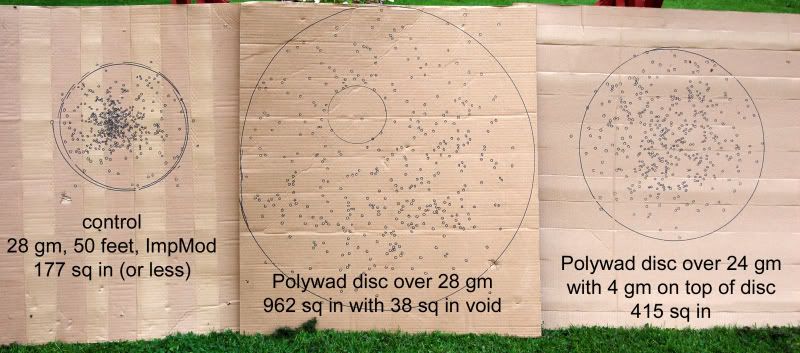these loads were fired through the same barrel at the same distance.... a mere 50 feet. They were constructed as identically as possible; the only variable being the inclusion and positioning of the Polywad disc.

The first pattern is representative of what I throw at sporting clay, FITASC, international trap and 16-yard ATA targets.
The middle pattern explains why I don't load the Polywad insert as recommended. A few patterns like that convinced me I should not use such a spreader load on live birds and most certainly never over a bird dog.
The third pattern is representative of the spreader loads I make. I load them on a MEC9000-G progressive press in normal operational mode. A standard load requires about 2-3 minutes per box of 25; the spreader adds one minute per box.
The layering method was suggested to me by Robert Harris. Author Wallace Labisky, discussed it in an article (possibly Handloader magazine?), and credited Jay Menefee, the purveyor of the Polywad discs. The focus of the article was the (then new) disc with the 3 holes in it, presumably to allow some shot to pass through and help fill the pattern voids that sometimes arise with the standard disc. Theses voids were acknowledged to occur and two possible solutions were suggested...the layering technique (which is not mentioned in the directions for use that come with the spreaders) or the new & improved disc with holes.
The void is seen in the center pic; I found it to be present in roughly 1 of 8 patterns I shot. I tried some of the discs with holes and ultimately settled on the layering technique. The use of 1/8 ounce of shot on top of the disc is purely arbitrary. The difference between zero shot on top and 1/8 ounce on top is remarkable. I surmise the post on the disc helps to keep the disc flat and perpendicular to the shot column as it travels down the bore and perhaps for a short distance after exit. This creates the maximum impedance to the shot, and more reproducibly than the cardboard overshot card that could tip and cause the "blown" patterns that Remington described in their advertising of the 1940's. Maybe the 1/8 ounce shot on top of the disc further enhances reproducibility. In any event, it seems the shot on top sees the full effect of choke and goes to the core of the pattern offering a means to modify the spread effect. Thatt raises the question of what would result by varying the quantity of shot on top...experiments I didn't pursue.
My personal use is limited to sporting clay rabbit targets inside 20 yards. It's just an idiosyncrasy of mine that I can smoke 15-yard airborne targets with my fixed IM chokes but my little pea brain won't allow me to cover up and blot out a close bouncing rabbit target. With my fixed IM chokes the spreader allows me any combination of SK/SK, SK/IM & IM/IM that I want. It also gives me the option of changing chokes in the middle of a sequence...something a choke-tube user can't do.